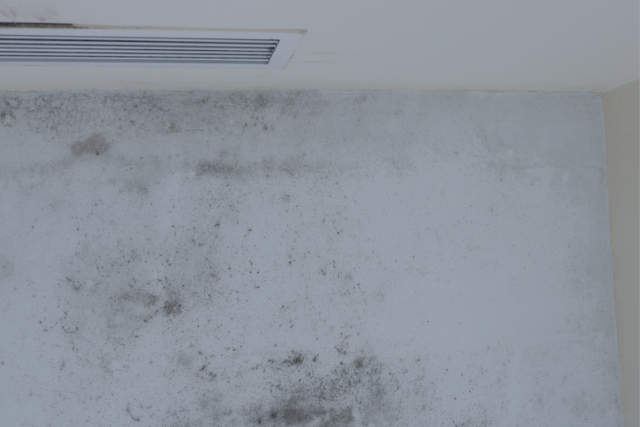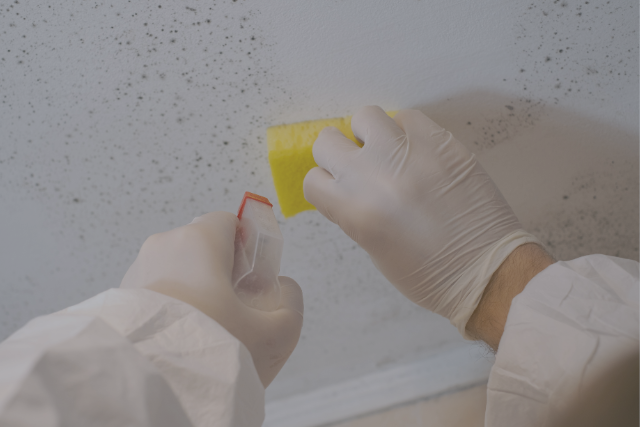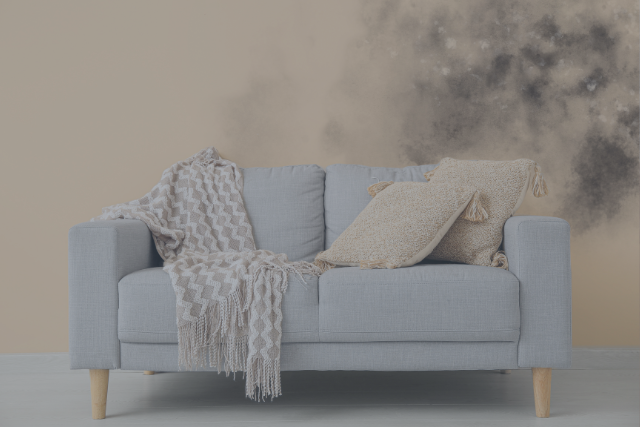What is mold and why is it considered a biological contaminant?
Mold is a microscopic, multicellular fungus that reproduces through spores. These spores are naturally present in the environment, but when combined with persistent moisture, a stable temperature, and organic material, they can begin to colonize surfaces inside homes or offices.
Indoors, mold behaves like a biological contaminant. It releases spores and metabolic compounds into the air that can affect human health in acute or chronic ways. For sensitive individuals, exposure often leads to allergic, respiratory, immune, and even neurological responses.
Below, I’ll explain the most common molds found in indoor spaces and how they’re directly linked to health.
Stachybotrys chartarum (Toxic black mold)
This dark mold grows slowly on cellulose-rich materials like drywall, cardboard, or insulation—especially when those materials have been wet for more than 72 hours. It’s commonly found in buildings with a history of water damage.
It produces trichothecene mycotoxins, particularly satratoxins, which can impact respiratory tissues, mucous membranes, and even the central nervous system. Exposure may lead to inflammation in the airways, nosebleeds, immune suppression, and neurological symptoms like fatigue, brain fog, and chemical sensitivity. It’s especially dangerous for children and immunocompromised individuals.
Aspergillus spp.
This genus includes several species commonly found indoors, such as Aspergillus fumigatus, flavus, and niger. It thrives in dust, stored food, air ducts, and moist surfaces. Because its spores are extremely small—just 2 to 4 microns—they can penetrate deep into the lungs.
It can trigger a range of issues, from allergic reactions to serious lung infections. People may develop allergic bronchopulmonary aspergillosis, fungal sinusitis, mold-induced asthma, or even infections in existing cavities in the lungs. In those with weakened immune systems, it can be particularly harmful.
Penicillium spp.
While some species of Penicillium are used to produce antibiotics, others release mycotoxins like penitrems and citrinin, which may have neurotoxic or hepatotoxic effects. This mold spreads quickly across damp walls, wood, food, carpets, and insulation. Its dry, lightweight spores disperse easily into the air.
It’s often associated with chronic nasal congestion, sinus infections, allergic symptoms, reduced lung function in certain environments, and sensitization over time in people with repeated exposure.
Cladosporium spp.
This is one of the most common molds, both outdoors and indoors. It appears frequently in HVAC systems, window frames, textiles, and areas where light condensation accumulates. While it doesn’t produce powerful mycotoxins, its high spore count makes it a potent allergen for many people.
It can lead to rhinitis, conjunctivitis, worsening asthma, or even skin reactions like dermatitis. In individuals with compromised immune systems, it can cause superficial infections on the skin or in the sinuses.
Alternaria spp.
Alternaria is a dark-pigmented mold that grows quickly in areas with excess moisture and poor ventilation, such as bathrooms, kitchens, or places with roof leaks. Its large spores can cause strong allergic reactions, especially in sensitive individuals.
It’s been linked to asthma attacks, bronchial inflammation, skin rashes, and increased hospital visits in children with poorly controlled asthma. Long-term exposure can also lead to mold sensitization, making individuals more reactive over time.
From my experience
In many inspections I’ve done, what surprises clients the most is realizing that the symptoms they feel every day—fatigue, allergies, shortness of breath—don’t always have a clear medical explanation. Sometimes, the real cause is in the air they breathe.
The problem with mold isn’t just that it’s present. The real risk lies in not knowing what kind of mold you’re dealing with, how long you’ve been exposed, or what effects might already be taking place. The difference between prevention and reaction can have a major impact on the health of a family—or the atmosphere of an entire office.
If you’re unsure, if there’s persistent moisture, if you’ve had leaks, or if you notice symptoms that only occur at home or at work, the best thing you can do is get a professional evaluation. Catching it early can save you money, prevent structural damage, and—most importantly—protect your health before things escalate.
A technical inspection gives you clear answers: what kind of mold is present, how serious the situation is, and what actions need to be taken. And with that information, you can make decisions with confidence—no guessing, no unnecessary risk.
If you’re concerned about mold exposure, start by reading our step-by-step inspection process or check our guide on early signs of mold at home. For medical insights, visit the Centers for Disease Control and Prevention – Mold page.



